Blindagem eletrostática – Resolução EN
ELECTROSTATIC SHIELDING – RESOLUTION
Entrance exam exercises with commented solutions on
Conductor in electrostatic equilibrium – Electrostatic shielding
01-(UFRN-RN) Mauro heard on the news that the prisoners at Carandiru, in São Paulo, were

commanding, from inside the prison, drug trafficking and prisoner escapes from other prisons in São Paulo, using cell phones. He also heard that a solution
The only way to prevent phone calls, since it was difficult to control the entry of phones into the prison, was to shield the electromagnetic waves using screens so that the calls would not go through. Mauro was unsure whether the screens were metal or plastic. He then decided to do two very simple experiments with his cell phone and his home landline.
1 – Mauro sealed a plastic bag with his cell phone inside. He picked up the landline and called the cell phone. The call was completed.
2 – Mauro repeated the procedure, closing a metal can with the cell phone inside. The call was not completed.
The fact that the connection was not completed in the second experiment is justified because the inside of a closed metal can
a) allows the polarization of electromagnetic waves, reducing their intensity.
b) is isolated from any external magnetic field.
c) allows destructive interference of electromagnetic waves.
d) is isolated from any electric field
02-(UFF-RJ) Consider the following experiment: “A scientist built a large metal cage,
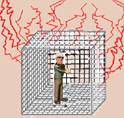
isolated it from the Earth and entered it. His assistant then electrified the cage, transferring a large charge to it.” It can be stated that:
a) the scientist was not hurt, as the potential of the cage was lower than that of his body.
b) the scientist did not suffer anything, as the potential of his body was the same as that of the cage.
c) even if the scientist had touched the ground, he would not have suffered anything, since the potential of his body was the same as that of the
Alone.
d) the scientist was shocked and thus proved the existence of electric current.
03-(AFA-RJ) During a storm, lightning strikes a plane in flight.
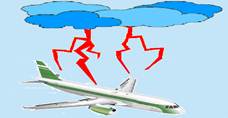
It can be stated that the crew:
a) it will not be hit, as airplanes are required to carry a lightning rod in their fuselage.
b) will be hit because the metal fuselage is a good conductor of electricity.
c) will be partially reached, since the load will be homogeneously distributed on the internal surface of the airplane.
d) will not suffer physical damage, as the metal fuselage acts as shielding.
04- (UFBA) Aircraft with metallic coating, flying in a dry atmosphere, can reach high

degree of electrification, often evidenced by a spark into the atmosphere, known as St. Elmo’s fire. In these circumstances it is correct to state:
(01) The electrification of the coating takes place by induction.
(02) The electric field inside the plane caused by the electrification of the coating is zero.
(04) Electrification could be avoided if the plane was covered with insulating material.
(08) Sparking occurs preferably on the sharp parts of the aircraft.
(16) The metal coating is not an equipotential surface, because if it were, there would be no sparking.
(32) Any two points inside the plane are at the same potential, as long as there are no other sources of electric field.
05-(UEM-PR) An isolated metallic sphere of radius R is charged with an electric charge Q. Let r be the distance from the center of the sphere to any point inside (r < R) or outside (r > R) the sphere. Under these conditions, mark the correct answer:
(01) The electric charge is distributed uniformly throughout the mass of the sphere.
(02) The electric field and the electric potential are constant inside the sphere.
(04) For r > R, the electric field is inversely proportional to the square of the distance and has a direction perpendicular to the surface of the sphere.
(08) The equipotentials associated with the electric field of the sphere, for r > R, are spherical surfaces concentric with the sphere and equally spaced.
(16) The electric potential is a scalar quantity, while the electric field is a vector quantity.
Give as your answer the sum of the numbers preceding the correct statements.
06-(FMTM-MG) The cross-section of a positively charged conductor in electrostatic equilibrium has a pear shape, as shown in the figure. Consider two points A and B on its surface and the following information about them:
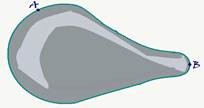
I. A and B are subjected to the same potential.
II. The electric field vector has the same intensity in A and B. III. The resulting electric field vector inside the conductor is zero. From the above statements: ![]()
![]()
a) Only II is correct.
b) Only II and III are correct.
c) Only I and II are correct.
d) Only I and III are correct.
e) I, II and III are correct.
07-(PUC-MG) The absence of electrostatic charges inside electrical conductors, whatever their form, is related to the fact that:
a) the electric potential is zero inside conductors.
b) the surface charge density is constant.
c) the electric field is zero inside conductors.
d) electrical charges do not move easily in conductors.
e) it is not possible to completely isolate a conductor
08-(CEFET-PR) A cube is made of aluminum and is electrified and in electrostatic equilibrium. As for the

electric field, we can say that this is:
a) more intense near the centers of the cube’s faces.
b) more intense near the centers of the cube’s edges.
c) more intense near the vertices of the cube.
d) of equal intensity in the vicinity of any part of the cube.
e) as intense nearby as inside.
09-(UFMG) A rod is rubbed with wool, so that it acquires a positive charge. The rod is then brought close to a metal sphere with the aim of inducing a separation of charges in it. This situation is shown in the figure.

It can then be stated that the electric field inside the sphere is:
a) non-zero, horizontal, from right to left.
b) non-zero, horizontal, from left to right.
c) null only in the center.
d) null.
10-(UFV-MG) During a storm, lightning strikes a bus traveling on a highway.
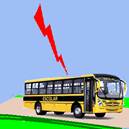
It can be stated that passengers:
a) they will not suffer physical damage as a result of this fact, as the rubber tires ensure the electrical insulation of the bus.
b) will be hit by the electric discharge, because the metal body is a good conductor of electricity.
c) will be partially affected, as the load will be evenly distributed on the internal surface of the bus.
d) they will not suffer physical damage as a result of this fact, as the metal body of the bus acts as shielding.
e) they will not be hit, as intercity buses are required to carry a lightning rod on their body.
11-(UFMT) Indicate the technological application of the concept demonstrated by Faraday, in the first half of the 19th century, in the experiment known as the Faraday cage.
a) Thermal insulation of the contents of thermal bottles.
b) Attraction of lightning in storms by lightning rods.
c) Electrical insulation provided by the rubber in vehicle tires.
d) Covering with insulating material on cables used to transport electrical energy.
e) Blocking of cell phone calls in prisons.
12-(UFU-MG) A small metal ball, charged with an electric charge –Q, is held by a wire inside a thin, neutral, conductive spherical shell, as shown in the figure below.

The ball is in a non-concentric position with the spherical shell.
Based on this information, indicate the alternative that corresponds to a true physical situation.
a) If the wire is made of insulating material, the ball will not exchange electrical charges with the conductive spherical shell, but will induce a total charge + Q in the shell, which will be distributed over the external part of the shell, assuming a configuration as shown below.
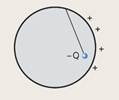
b) If the wire is made of conductive material, the ball will exchange electrical charges with the spherical shell, becoming neutral and producing a total charge – Q in the spherical shell, which will be evenly distributed over the outer part of the shell, as shown below.
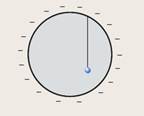
c) If the wire is made of insulating material, there will be an electric field in the internal region of the spherical shell due to the charge – Q of the ball, but there will be no electric field in the region external to the neutral spherical shell.
d) If the wire is made of conductive material, there will be an electric field in the internal and external regions of the spherical shell, due to the exchange of charges between the ball and the spherical shell.
13-(ENEM-MEC) The power of the tips is a consequence of the way in which the particles carrying electrical charge are distributed

on the surface of a conductor. In a given charged conductor, in electrostatic equilibrium, it can be stated that, in relation to the rest of the surface, at the ends:
a) the quantity and density of charges are always greater.
b) the quantity and density of charges are always smaller.
c) the quantity and density of charges are always the same.
d) the amount of charges is always smaller, but the charge density is always greater.
e) the amount of charges is always greater, but the charge density is always lower.
14-(UFRGS-RS) The figure below represents, in cross-section, three objects of different geometric shapes, made of good conductor material, which are at rest. The objects are hollow, completely closed, and their internal cavities are empty. The surface of each of the objects is charged with a static electric charge of the same value Q.

In which of these objects is the electric field zero at any point in the internal cavity?
a) Only in I.
b) Only in II.
c) Only in I and II.
d) Only in II and III.
e) They are I, II and III.
15-(UFMS-MS) The Van de Graff generator is a device capable of generating electrical charges that are stored in its dome. The figure below shows a generator dome charged with an excess of negative electrical charges. And, far from this dome, another system, formed by a solid conductive sphere, held by insulating supports inside a conductive spherical shell. The spherical shell is supported to the ground by another support that is also insulating. The generator dome and the internal conductive sphere are connected by a conductive wire, which can be turned on and off by means of a switch S 1 . Another conductive wire makes the connection, through another switch S 2 , between the external surface of the spherical shell and the ground. An uncharged electrostatic pendulum is in equilibrium, close to the external surface of the spherical shell. The pendulum can be electrostatically attracted to this surface, so that it does not touch it. Initially, the switches are off, and the conducting sphere, the spherical shell and the pendulum are uncharged. Consider the generator dome to be far enough away so that the electric field produced in the vicinity of the dome does not interfere with the second system, including the pendulum. Regarding this entire set, it is correct to state:

01) If we only turn on the switch S 1 , keeping S 2 off, the pendulum will be attracted.
02) If we turn on S 1 , and then turn on S 2 , keeping S 1 also turned on, the spherical shell will be charged and the pendulum will not be attracted.
04) If we turn on S 1 , keeping S 2 off, the electric field in the pendulum region will remain zero.
08) If we connect S 1 , and then connect S 2 , the spherical shell will be charged with excess positive charges.
16) If we turn on only S 1 , keeping S 2 turned off, the spherical shell will be charged with an excess of negative charges.
Data to resolve questions 16 and 17 .
16-(PUC-MG) A metallic sphere of radius R = 0.50 m is charged with a positive charge and in
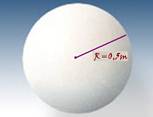
electrostatic equilibrium, so that its surface charge density is 1.0.10 -6 C/m 2 . The sphere is in a vacuum.
Dado: K o = 9,0.10 2 N m 2
The sphere is charged with an electric charge of:
![]()
17-(PUC-MG) The electric field for points that are at a distance of 30 cm from the center of this sphere is:
![]()
18-(PUCCAMP-SP) A hollow metallic sphere is in the air, positively electrified and isolated from other charges. The following graphs represent the intensity of the electric field and the electric potential created by this sphere, as a function of the distance from its center. Given: k = 9.0.10 9 Nm 2 /C 2 .
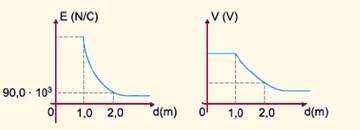
Based on the information, it is correct to state that:
a) the electric charge of the conductor is 4.5.10 -6 C.
b) the electric potential inside the conductor is zero.
c) the electrical potential of the conductor is 3.6.10 4 V.
d) the electric potential of a point 2.0 m from the center of the conductor is 90.10 3 V
e) the intensity of the electric field at a point 3.0 m from the center of the conductor is 4.0.10 4 N/C.
19-(UEG-GO) Recent riots in Brazilian prisons have drawn widespread attention to the importance of telecommunications in the operation of organizational structures. The need to prevent any type of communication in the case of criminal organizations has become clear. Although there are many mobile communication systems, the focus has been on cell phones, due to their small physical size and ease of purchase and use. Several proposals have been put forward to block electromagnetic or radio waves. The first of these involves enclosing the prison in a “Faraday cage”, that is, “wrapping” it with a material that is a good conductor of electricity and connected to the ground. A second proposal was to use a device that would generate electromagnetic waves in the same frequency range used by mobile phone operators. These waves would be scattered by means of antennas, normally installed on the prison walls.
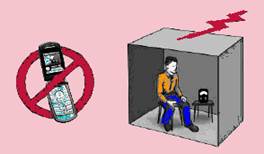
Regarding the information contained in the text above, judge the validity of the following statements.
I. A “Faraday cage” is an electrical shield, that is, a conductive surface that surrounds a given region of space and that can, in certain situations, prevent the entry of disturbances produced by external electric and/or magnetic fields.
II. The efficiency of the “Faraday cage” depends on the wavelength of the electromagnetic waves of cellular telephony, as this will define the dimensions of the mesh used in its construction.
III. The second proposal mentioned in the text is the generation of waves at the same frequencies used by mobile phone operators. This compromises communication between the ERB (cell tower or radio station) and the telephone through destructive interference.
Select the CORRECT alternative:
a) Only statements I and II are true.
b) Only statements I and III are true.
c) Only statements II and III are true.
d) All statements are true.
20-(ITA-SP) An isolated metal sphere, with a radius of 10.0 cm, is charged in a vacuum until it reaches a potential of U = 9.0 V. It is then placed in contact with another isolated metal sphere, with a radius of R 2 = 5.0 cm, which is initially neutral. After equilibrium is reached, which of the alternatives below best describes the physical situation?
K=1/4πεo=9,0.109N.m2/C2
Given:.
a) The larger sphere will have a charge of 0.66.10-10C.
b) The larger sphere will have a potential of 4.5 V.
c) The smaller sphere will have a charge of 0.66.10-10C.
d) The smaller sphere will have a potential of 4.5 V.
e) The total charge is equally divided between the two spheres.
21-(UFPR-PR) The process of electrification by friction, or triboelectrification, is responsible, in part, for the accumulation of charges in the clouds and, in this case, the clearest manifestation of this accumulation of charges is the existence of lightning, which are electrical discharges
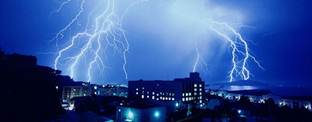
extremely dangerous. However, since atmospheric air is an insulating material, lightning does not occur all the time. For it to occur, the value of the electric field produced in the air by a charged object must have an intensity greater than a certain critical value called dielectric strength. It is important to note that not only air, but all materials, whether insulating or conducting, have dielectric strength. In conductors, in general, this quantity has values much lower than in insulators, and this is a characteristic that differentiates them. Thus, with a low-intensity electric field it is possible to produce movement of charges in a conductor, while in an insulator the necessary field must be much more intense.
Considering this information, answer:
a) It is known that the dielectric strength of air in a certain region is 3.0.10 6 N/C. What is the maximum charge that can be stored by a spherical conductor with a radius of 30 cm placed in this region?
b) Assuming that the electric potential at a very large distance from the conductor is zero, what is the value of the electric potential produced by this spherical conductor on its surface when it has the maximum charge determined in the previous item?
22-(Olimpíada Paulista de Física) A metal sphere of radius R 1 = 5.0 cm is charged with 4.0.10 -3 C. Another metal sphere of radius R 2 = 15.0 cm is initially uncharged. If the two spheres are electrically connected, we can state that:
a) the total charge will be equally distributed between the two spheres.
b) the charge of the larger sphere will be 1.0.10 -3 C.
c) the charge of the smaller sphere will be 2.0.10 -3 C.
d) the charge of the larger sphere will be 3.0.10-3C.
e) the charge of the smaller sphere will be 3.0.10-3C .
23-(ITA-SP) Consider a spherical conductor A with a diameter of 20 cm placed on a fixed and insulating pedestal. A conductive sphere B with a diameter of 0.5 mm, made of the same material as sphere A, is suspended by a fixed and insulating wire. Opposite sphere A, a bell C connected to ground is placed, as shown in the figure. Conductor A is then charged to an electrostatic potential V o , so as to attract sphere B. The two spheres come into contact due to electrostatic induction and, after the transfer of charge, sphere B is repelled, colliding with bell C, where the acquired charge is drained to ground. After 20 contacts with the bell, it is found that the potential of sphere A is 10000 V. Determine the initial potential of sphere A.
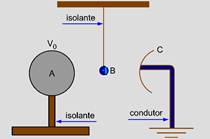
Considere (1 + x)n ≈ 1 + nx se │x│ < 1
24-(UFC) A copper sphere with a radius of the order of micrometers has a charge of the order of ten thousand elementary charges (e=1.6.10 -19 ), uniformly distributed over its surface. Consider that the surface density is kept constant. Select the alternative that contains the order of magnitude of the number of elementary charges in a copper sphere with a radius of the order of millimeters.
![]()
25-(ITA-SP) A charge q is uniformly distributed on the surface of an isolated, conducting sphere of radius R. Select the option that presents the magnitude of the electric field and the electric potential at a point located at a distance r = R /3 from the center of the sphere.

26-(UFRGS) The figure shows a sphere of radius R inside a spherical shell of radius 2R,
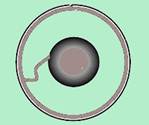
both metallic and interconnected by a conducting wire. When the system is charged with total electric charge Q, it will be distributed so that the charge of the inner sphere is:
![]()
27-(UECE-CE) Two spherical electrical conductors, with radii R 1 and R 2 , with R 1 twice as much as R 2 , are

electrified with charge density e , so that they are maintained at the same electric potential V, and are located far apart from each other. We can correctly state that ![]()
![]()
a) ![]() . b)
. b) ![]() . c)
. c) ![]() . d)
. d) ![]() .
.
28-(UPE-PE) In the following figure, two charged spherical conductors A and B, whose radii are respectively and , are separated by a distance much greater than 6 cm and connected by a long thin conductive wire. A total charge is placed on one of the spheres. ![]()
![]()
![]()
Considering the electrostatic constant in vacuum , ![]()

It can be stated that:
00. the electric potential at the surface of conductor A is less than the electric potential at the surface of conductor B.
01. the electric potential inside conductor A is greater than the electric potential inside conductor B.
02. the electric charge on conductor A is three times the electric charge on conductor B.
03. the electric field is the same on the surface of both conductors.
04. the electric potential on the surface of conductors A and B is the same and is worth . ![]()
29-(UFSC) Two isolated conducting spheres have radii R and 2R and are separated by a distance a. Initially, the larger sphere has an excess positive charge +q and the smaller one is neutral. One sphere is placed against the other and then both are returned to their initial position.
In this last situation, it is CORRECT to state that:
01) the electrostatic force between the spheres is k o (q 2 /4a 2 ) .
02) the smaller sphere has charge +(1/3)q and the larger one, +(2/3)q .
04) the electric potential in the larger sphere is half the value of the potential in the smaller sphere.
08) all the excess charge of the smaller sphere is located on its surface.
16) the electric field inside the smaller sphere is zero.
32) potential difference between any two points inside the larger sphere is nonzero.
30-(UFRJ-RJ) A particle with a positive charge q = 4.0.10 -6 C is kept at rest in front of an isolated solid conducting sphere of radius 0.10 m and zero total charge. The particle is located at a distance of 0.20 m from the center of the sphere, as illustrated in the following figure. The sphere and the charges that were induced on its surface are also at rest, that is, there is electrostatic equilibrium.
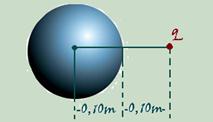
Knowing that the constant of proportionality in Coulomb’s law is k = 9.0.10 9 N.m 2 /C 2 , determine the module and indicate the direction:
a) the electric field at the center of the conducting sphere due to the particle with charge q;
b) the electric field at the center of the conducting sphere due to the charges induced on its surface.
31-(PUC-MG) On dry days with low humidity, it is common to get an electric shock when
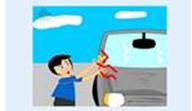

if you touch a car or a door handle in places where the floor is covered with carpet. Small electric sparks jump between people’s hands and these objects. Electric sparks occur in the air when the difference in electrical potential reaches 10,000 V at a distance of approximately 1 cm. In this regard, mark the CORRECT option.
a) The person receives this shock because the human body is a good conductor of electricity.
b) This phenomenon is an example of static electricity accumulated in objects.
c) This phenomenon only occurs in environments where there are electrical wiring, such as vehicles and residential and commercial environments.
d) If the person is wearing dry rubber shoes, the phenomenon does not occur, because rubber is an excellent electrical insulator.
32-(UPE-PE) A spherical conductor in electrostatic equilibrium, represented by the following figure,

has a radius equal to R and is electrified with charge Q. Analyze the following statements:
I. At point A, the electric field and the electric potential are zero.
II.On the surface of the sphere E B = V B /R
III. At point C, the electric potential is given by KQ/R
IV. At point C distant from point A of 2R, we have E C = V C /2R
It is CORRECT to state that only the following statements
a) I and III are correct.
b) IV is correct.
c) II and IV are correct.
d) III and IV are correct.
e) II and III are correct.
33-(IFSP-SP) A sphere A, with a radius of 2 cm, is uniformly electrified with a charge of 2mC. In a
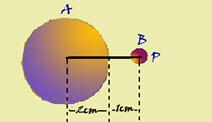
At point P, located 1 cm from the surface of this sphere, an electrically charged particle B with a charge of 5nC is placed. The electric field of charge A at point P, the force exerted by B on A, and the electric potential at point P are, respectively
(use k 0 = 9 . 10 9 N.m 2 /C 2 )
a) E = 2´108 N/C, F = 10–2 N, V = 6´105 V.
b) E = 2´108 N/C, F = 10–1 N, V = 6´106 V.
c) E = 2´107 N/C, F = 10–1 N, V = 6´105 V.
d) E = 2´107 N/C, F = 10–2 N, V = 6´104 V.
e) E = 2´107 N/C, F = 10–2 N, V = 6´106 V.
34-(UFCG-PB) A copper sphere of radius R is electrically charged with charge Q. The potential V, as a function of the radius r where r = 0 at the center of the sphere, is shown in the figure. Considering this configuration, it can be stated that:
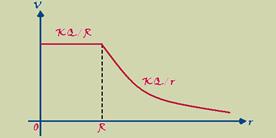
a) the work done to transport a test charge +q o , from r = 0 to r = R/2 is worth 2kQq o /R.
b) the work done to transport a charge –q o , where |q o | << |Q|, from r >> R to r =R , depends on the radius of the sphere.
c) while the sphere is being charged, its electric potential as a function of r has the same behavior shown in the figure.
d) with the available information it is not possible to calculate the surface charge density of the sphere.
e) according to Faraday’s representation, as V is constant inside the sphere, the electric field force lines are parallel in this region.
35-(ENEM-MEC)

Two sisters who share the same study room agreed to buy two boxes with lids to store their belongings inside their boxes, thus avoiding clutter on the study table.

One of them bought a metal one, and the other, a wooden box with different areas and side thicknesses, to make identification easier. One day the girls went to study for the Physics test and, when they sat down at the study table, they put their switched on cell phones inside their boxes.
Throughout the day, one of them received phone calls, while the other’s friends tried to call and received the message that the cell phone was out of coverage area or turned off.
To explain this situation, a physicist would have to state that the material of the box whose cell phone did not receive the calls is
a) wood and the telephone did not work because wood is not a good conductor of electricity.
b) metal and the phone did not work due to the electrostatic shielding that the metal provided.
c) metal and the phone didn’t work because the metal reflected all types of radiation that hit it.
d) metal and the phone did not work because the side area of the metal case was larger.
e) wood and the telephone did not work because the thickness of this box was greater than the thickness of the metal box.
36-(UNICAMP-SP)

When a roll of adhesive tape is unrolled, a transfer of negative charges from the tape occurs
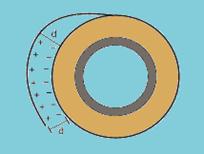
to the roll, as illustrated in the following figure. When the electric field created by the charge distribution is greater than the breakdown electric field of the medium, an electric discharge occurs. It has recently been demonstrated that this discharge can be used as an economical source of X-rays.
For a piece of tape with area A = 5.0.10 -4 m 2 kept at a constant distance d = 2.0 mm from the roll, the amount of accumulated charges is equal to Q = CV, with V being the potential difference between the unwound tape and the roll and C = ε o A/d, where
ε o 9.10 ≈ -12 10 C/Vm. In this case, the potential difference between the tape and the roll for Q = 4.5. -9 C is for
![]()
37-(UCPEL-RS)
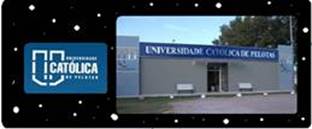
Consider the statements below.
I. The force between two electric charges in electrostatic equilibrium is independent of the medium in which these charges are immersed.
II. Two aluminum rods, one neutral and the other positively charged, are brought into contact and then moved apart. After being moved apart, the neutral one has lost electrons.
III. Two bodies of the same material, initially neutral, are rubbed together. Both become electrified with a charge of the same sign.
IV. On an equipotential surface, the lines of force will always be perpendicular to any point on the surface.
V. For a positively charged metallic sphere, the electric field inside it is constant and greater than zero.
From the above statements, it can be concluded that
(A) II and IV are correct.
(B) I, III and V are correct.
(C) all are correct.
(D) all are incorrect.
(E) I, II, IV and V are correct.
38-(UEM-PR)

Considering a solid, spherical metallic electrical conductor, of radius R, positively charged and
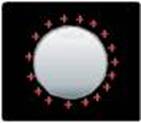
arranged in a vacuum, mark the correct one.
01) For points d < R, inside the conductor, the electric field is zero.
02) For points D > R, the electric field generated at D is proportional to D 2 .
04) The surface density of charges in the conductor is σ = Q/4πR 2 .
08) The electric potential inside the conductor varies, in the form V=KQ/d, with d < R.
16) The surface of this spherical electrical conductor is an equipotential surface.
39-(UEM-PR)

Mark the correct ones.
01) Positive electric charges, left at rest in a region of space, where there is a uniform electric field, move to the region of lower electric potential.
02) Negative electric charges, left at rest in a region of space, where there is a uniform electric field, move in the direction of the field.
04) Electric field force lines are always perpendicular to equipotential surfaces.
08) Conservative force fields, such as the electric field, are associated with the concept of potential.
16) In a conservative field, such as the electric field, the work done by a conservative force to
moving a particle from one point in the field to another is independent of the particle’s trajectory.
40-(ACAFE-SC)

A booklet provided by the country’s DETRANs warns about the risk in the event of an accident and electrical cables coming into contact with vehicles. This booklet contains a conceptual error when it states: “People are safe inside vehicles, as long as the tires are intact and there is no contact with the ground. If the cable is on the vehicle, they can be electrocuted when they touch the ground. This does not happen if they remain inside the vehicle, since it is insulated by the tires.”
Notions of First Aid in Traffic, p. 25/São Paulo: ABRAMET – 2005
Select the correct alternative that provides a scientifically adequate justification for the situation described in the booklet.
A) People will never be safe because tires do not have adequate insulation.
B) People must remain inside the car because they are electrically shielded, regardless of whether they are isolated by the tires.
C) The tires must be filled with air, otherwise there will be no insulation.
D) If people are wearing rubber shoes they can jump out of the car.
41-(FUVEST-SP)

The flow of ions through cell membranes generates electrical impulses that regulate physiological actions in living beings. The figure below illustrates the behavior of the electrical potential V at different points inside a cell, in the cell membrane and in the liquid.
extracellular.
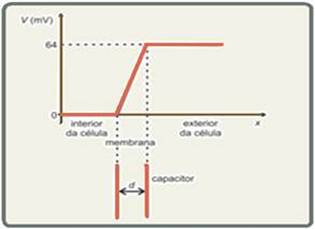
The graph of this potential suggests that the cell membrane can be treated as a parallel-plate capacitor with the distance between the plates equal to the membrane thickness, d = 8 nm. In the context of this model, determine
a) the direction of movement – from inside to outside or from outside to inside the cell – of chlorine ions (Cl – ) and calcium ions (Ca 2+ ), present in the intra and extracellular solutions;
b) the intensity E of the electric field inside the membrane;
c) the intensities F Cl and F Ca of the electrical forces that act, respectively, on the Cl + and Ca 2+ ions as they cross the membrane;
d) the value of the electric charge Q on the surface of the membrane in contact with the outside of the cell, if the capacitance C of the system is equal to 12 pF.
